Main menu
You are here
Home ›Strangways Springs
Designation:
Australia-SA_Strangways
Location:
| Latitude | Longitude |
|---|---|
-29.146090° | 136.569885° |
Locality and ownership:
SA State Heritage Register. Anna Creek Station SA Pastrol Lease 2433
Access:
37km south of William Creek, and 1km west of the Oodnadatta Track.
Local contacts:
Nearest services:
Risks:
General access could be limited by even light rainfall.
Terrain:
spring mounds
General:
Strangways springs forms an elongated dome about 3 kilometres long by 2 kilometres wide and up to 10 metres high. This area has numerous circular mounds formed by spring activity that are dispersed irregularly over this larger structure; they are up to 10 metres wide and 3 metres high. The mounds show various levels of active growth from old degraded mounds with little visible structure to ones with a distinct crater at the summit with fine sediment vegetation to a few that contain standing water as well as vegetation.
The mounds are built up of irregularly layered limestone tufa – calcium carbonate deposited around reads and other vegetation. In places, secondary white calcites together with black manganese oxides have been deposited in vanes and irregular spaces. The crater-like features at the summit show a distinct soft inner portion with or without water and distinct from a hardened outer rim. The mounds were clearly built up by outflow of mineralising water that progressively deposited layers of calcium carbonate much like that of a volcano.
Site descriptions:
- The average annual monthly min is 5 deg (July) and the average annual monthly max is 36 deg. The average annual rainfall is 150mm.
Climate:
Flora and fauna:
History:
The mounds have provided valuable water for aboriginies for hundreds of years and have also been an important source for Europeans in this inhospitable climate. The sites were once thought to be volcanic cones. Discovered in 1858 by Major Peter Warburton, this was the site of a homestead, a yard, a woolshed, a cemetery and a water tank. In the 1870’s Strangways was used as a repeater station on the overland telegraph line and used until 1896. The ruins of many buildings still remain at the site.
Analogue value:
Water springs in both their active mode and as old degraded features are useful in understanding possible springs on Mars. These springs are clearly oases of life in an otherwise hostile desert on Earth; similar springs may have been active on Mars. The dual importance of any upwelling of liquid water, both as an in situ resource and a possible biological harbour makes springs of this kind worthy of study.
References:
- van Oosterzee, P. A 2000. Field Guide to Central Australia. Marleston, SA: J.B. Books.
Map reference:


